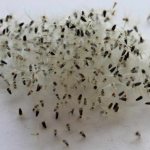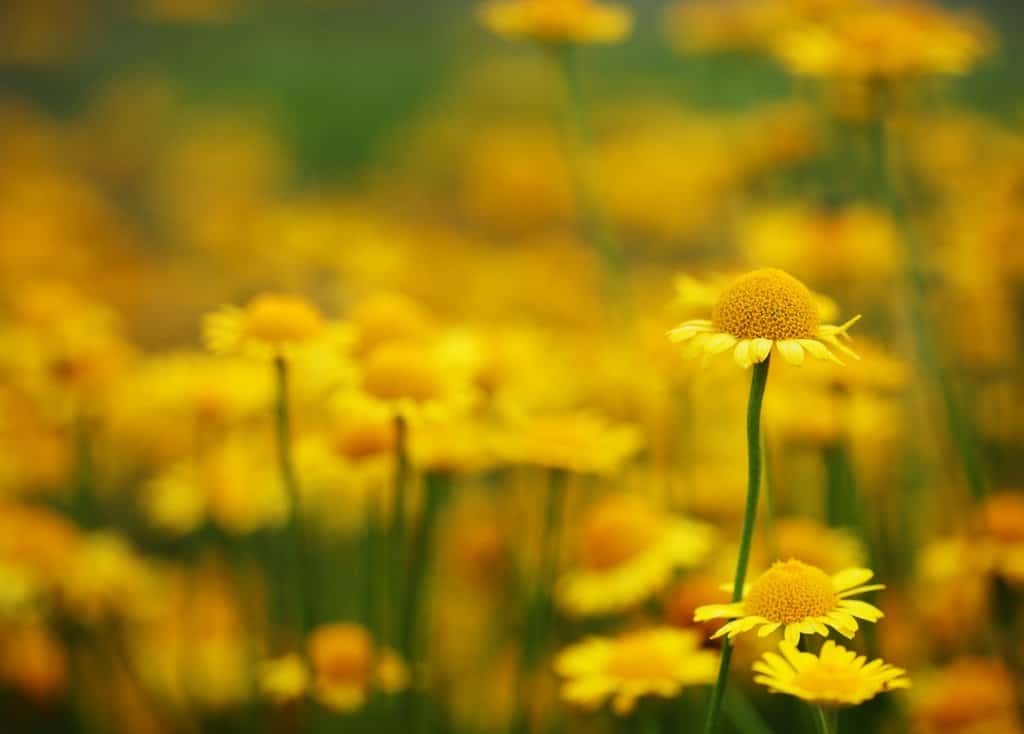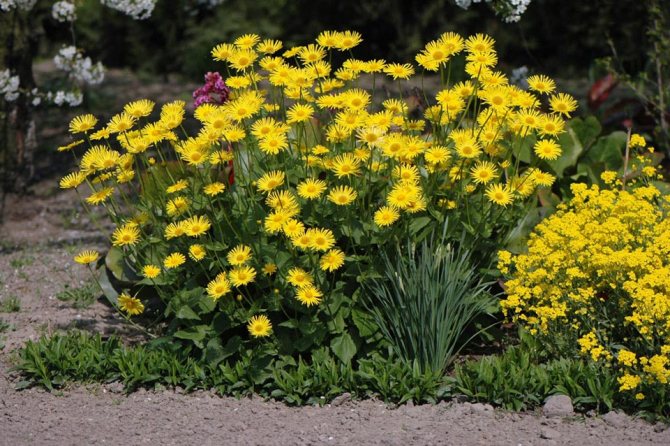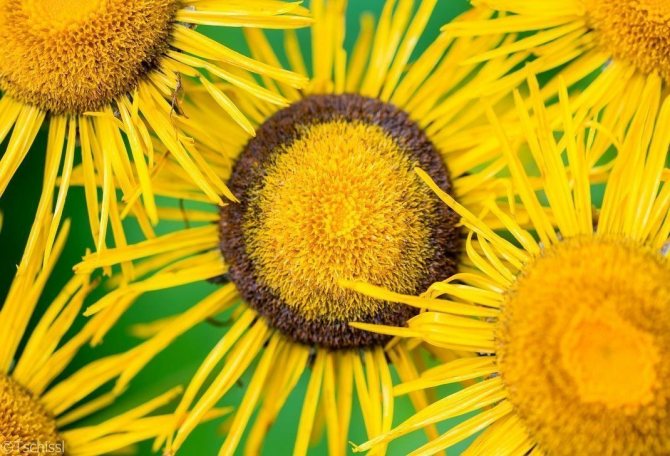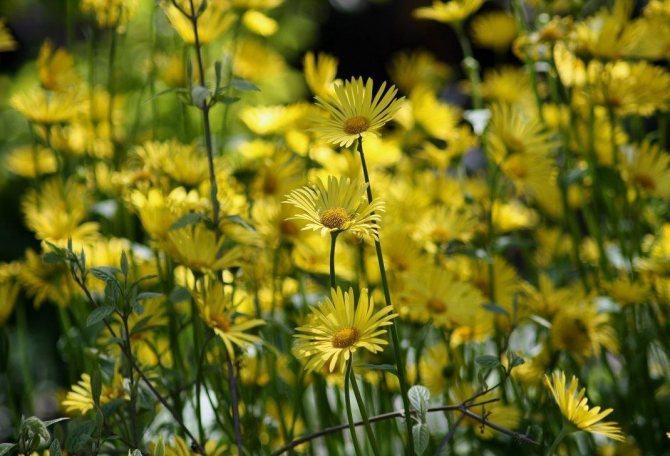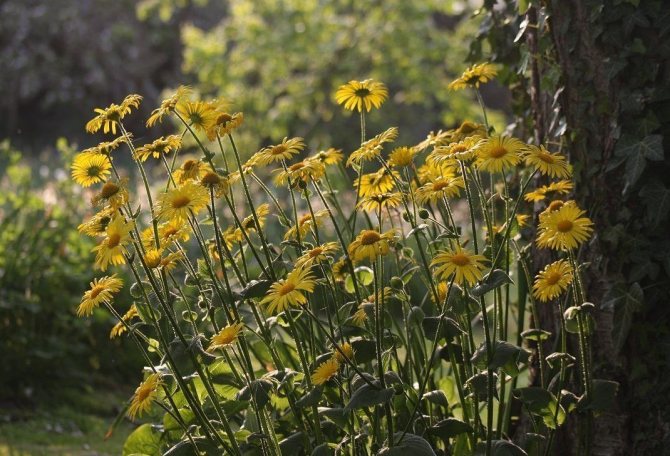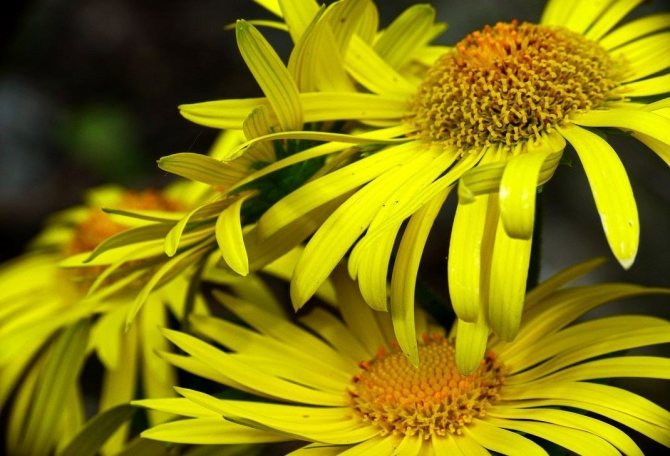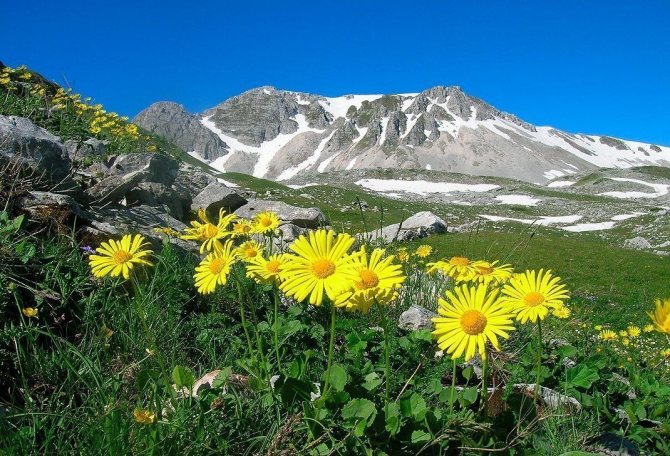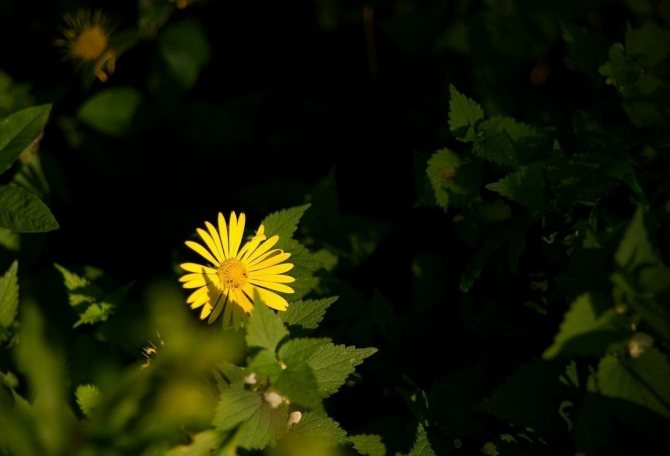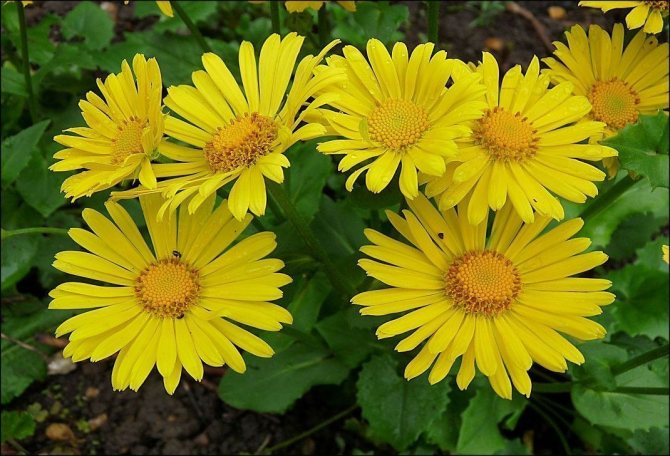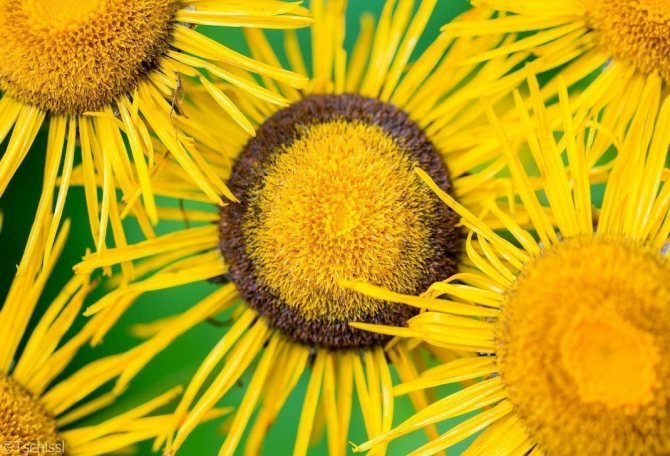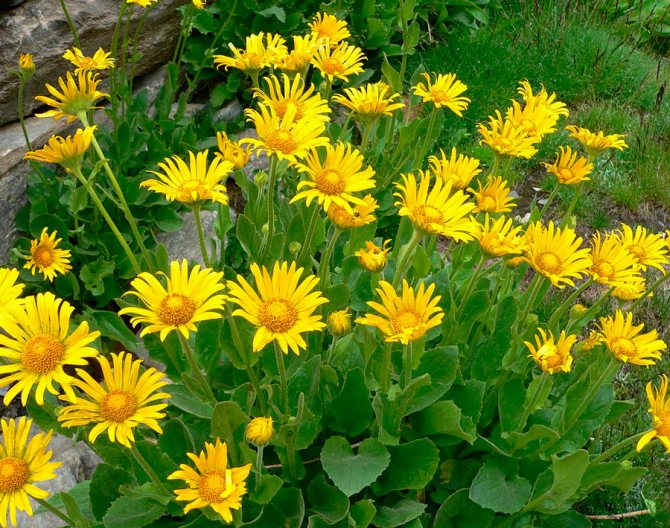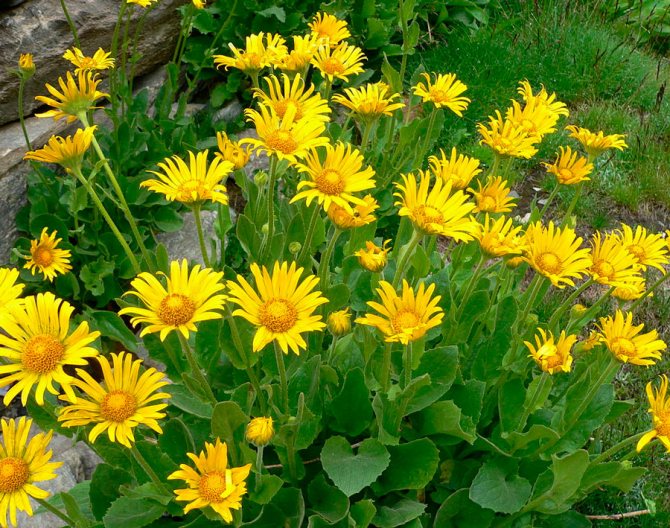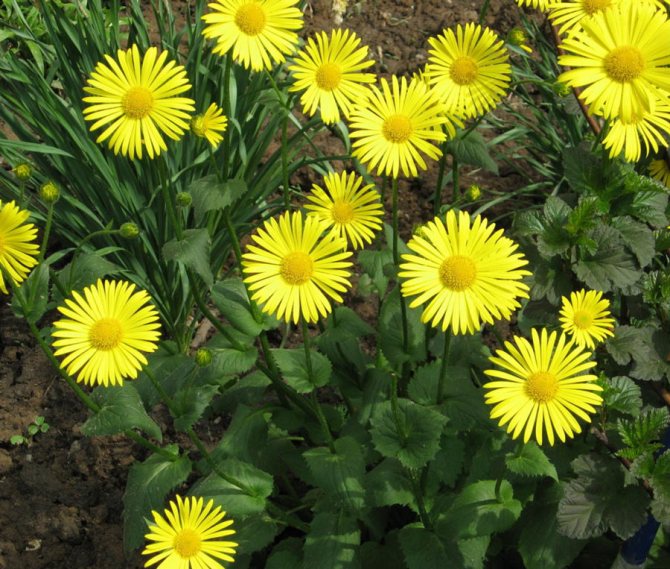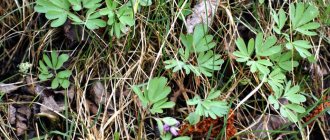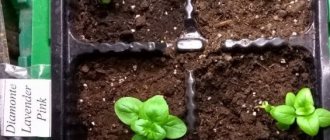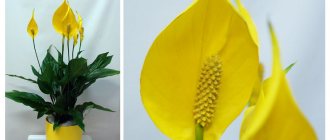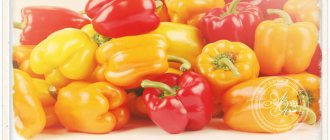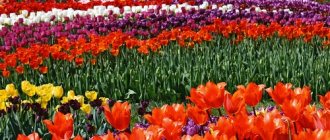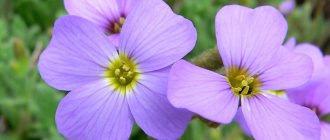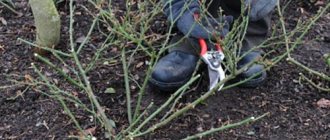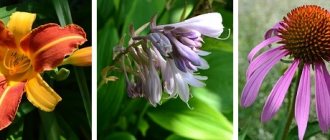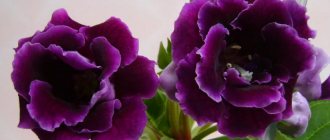The flowering plant Doronicum, also called the goat, is a member of the Asteraceae family. In nature, it is found in the mountains of Eurasia at an altitude of 3.5 thousand meters above sea level, as well as in regions with a temperate climate. Doronicum is also found in North Africa, but only 1 species. According to information taken from various sources, this genus unites 40–70 species. The scientific name of such a flower comes from the Arabic name for an unknown poisonous plant. They began to cultivate it in the 16th century, and it very quickly became popular among gardeners due to its undemanding care and attractive appearance.
Description of the plant doronicum
Doronicum is a perennial herb with a fibrous superficial root system. Strong, erect stem, reaching 30-100 cm in height, weakly branches. It has light green leaves of an elongated triangular shape, alternating along the stem. A dense basal rosette of leaves on long petioles, located at the base of the stem, is distinguished by a round or heart-shaped shape. Leaves and shoots have a "fluff", the bare edges of the stem leaves are covered with glandular formations.
By the end of March, the first flowers begin to open singly or form small corymbose inflorescences. A full yellow flower, consisting of 1-2 rows of long reed petals and a stuffed pith, reaches 5-12 cm in diameter.
After pollination, small achenes with brownish and dark brown longitudinal stripes ripen. The fruit, 2-3 mm long, contains miniature crested seeds that remain viable for about two years.
Doronicum Caucasian, tall, Clusy and cordate
A perennial relatively tall plant - up to 50 cm in height, belongs to the Asteraceae family. The flower stem is leafless, the leaves are only in the root rosette. The root system is voluminous, the roots are fleshy. Flower baskets are large, up to 8cm in diameter, with radiant yellow reed flowers. In Doronicum, about 40 species are known, and only a few are used in culture.
Doronicum Caucasian. Plant height 40-50 cm, blooms in May, yellow inflorescences.
Look at the photo - the doronicum flower of this species is very reminiscent of the daisy chamomile:
Doronicum tall - a plant up to 80 cm in height. Blooms a week later than Caucasian.
Doronicum Klusi grows on damp rocky hills, near ponds and garden pools. Reaches a height of about 40 cm. It has one yellow basket on the peduncle, the diameter of which is up to 6 cm. The wrapper consists of pubescent leaves. The lower leaves are preserved during the flowering period; they are heart-shaped. Blooms in July-August. More often it propagates by dividing the bushes, less often it is grown from seeds. Planting and caring for this doronicum flower is practiced in rock gardens in large group plantings, it is decorative and as a single plant, planted in front of tall grasses and next to water pools.
Doronicum cordate. Reaches a height of 30-70 cm. The lower leaves are usually one pair - ovoid-cordate, collected in a rosette; during the flowering period are preserved. There are 5-8 stem leaves. The golden yellow flower is about 4-6 cm in diameter.
Reproduction of doronicum
Reproduction is possible by seeds and vegetatively.
Sowing in the ground
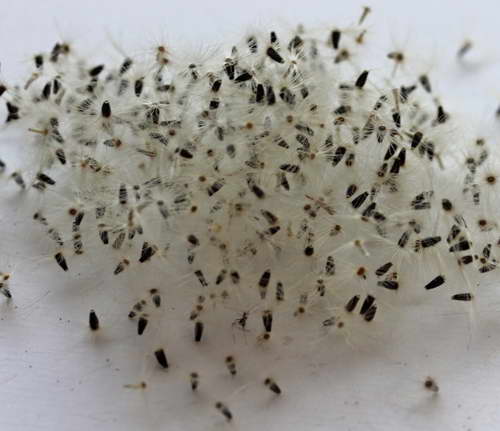
Doronicum seeds photo
- Doronicum is sown in open ground at temperatures above +16 ° C, starting in mid-April.
- The garden bed is prepared two weeks before sowing so that the earth settles.
- The seeding depth is 1-2 cm, the distance between the rows is 20 cm.
- When the seedlings sprout, you need to thin them out, leaving a distance of 7-8 cm.
- When the plants grow up to 10-12 cm in height, they are planted in a flower bed at a distance of about 25-30 cm.
Growing seedlings
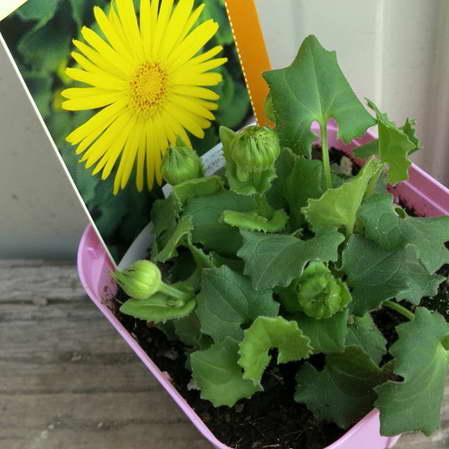

Doronicum seedlings ready for planting photo
- Seedlings should be grown in March, expecting seedlings for 7-10 days.
- When a couple of leaves appear on the seedlings, you can unpack them into separate cups.
- Water in moderation, provide long-term and adequate lighting.
- They are transplanted into open ground after the frost has receded (the seedlings are pre-hardened), keeping a distance of 30 cm between the seedlings.
In the first year of life, flowering is unlikely, the bush grows, increasing the root system.
Dividing the bush
The most popular reproduction is by dividing the bush, possible every 4 years in August or early September. It is necessary to dig up a plant with an earthen lump, carefully dividing it into parts with a knife, and immediately plant it in a new place. The transplant is well tolerated by the plant, and it takes root quickly.
Planting doronicum
As a classic perennial, the goat is thriving in all growing conditions. Therefore, a place can be allocated for it not only in a sunny meadow, but also in those parts of the garden where there is partial shade. This rule does not apply only to the plantain variety Doronicum, since you can observe abundant flowering if it grows in a sunny area. Based on the many years of experience of gardeners, we can say that areas with maximum illumination are most preferable for growing doronicum, since it grows here much longer than usual.
Doronicum will be primarily appreciated by those growers who always lack time to care for ornamental crops. This plant will be able to save the gardener from frequent watering thanks to its powerful root system, which is able to accumulate moisture in sufficient quantities. The goat can only need watering on days when the weather is dry and hot.
Kozulnik is a cold-resistant crop, therefore, when grown in the open field, you do not have to take special measures to protect it from temperature extremes.
Both experienced and novice florists will be able to appreciate the simplicity of doronicum care. But it must be borne in mind that loosening the soil in the root zone can harm the plant. because the root system is very close to the surface. Also, for the normal development of this flower culture, it is necessary to take measures to reduce the evaporation of moisture from the soil. A very effective measure is mulching the topsoil in the garden bed where the doronicum bushes are grown. As mulch, you can use wood chips, bark, hay or special materials that retard moisture evaporation.
With the end of flowering, the development of the aboveground part of the plant stops, and after that it goes into a dormant stage until the end of summer. From this time on, care for the doronicum should be minimal, it is necessary to reduce the frequency of watering. At the end of summer, the plant forms new shoots, so sometimes the doronicum can bloom again. In this case, the young shoots must be well watered and fed.
How to transplant doronicum
Although doronicum can grow in one place for up to 10 years, however, over time, plantings become very dense, the flowers become noticeably smaller, powdery mildew may develop. To avoid these problems, the bushes should be divided and transplanted every 5 years.
Do this in early spring or fall after the flowering stage is over. The plant is tolerant to the soil, but it grows especially luxuriantly on black soil, and sandy soils give bushes a little lower. Dig the ground to a depth of 20 cm, adding rotted manure, for heavy soils - sand and gravel, at the end pour abundantly.
Care
As mentioned above, due to the unpretentiousness of the doronicum, caring for it is simple. The flower prefers sunny places, but many species grow well in partial shade. In the dense shade of trees, doronicum may die.
The goat is resistant to summer heat and cold winters. Already blooming, it can easily endure short frosts. The plant winters well, but if a harsh winter is foreseen, it is better to come up with some kind of root cover.
It is necessary to water the doronicum regularly, but in moderation, the root system is located near the very surface of the soil. Stable irrigation extends flowering time. So that the soil does not dry out quickly, it is mulched with sawdust, last year's foliage. However, waterlogging can be detrimental to the flower.
Fertilizer
When flowering begins, it is recommended to feed the goat with mineral fertilizers in the form of a solution. If the soil is fertile, then feeding is not required, although the plant will accept it with gratitude.
During the formation of young rosettes, it will be appropriate to introduce organic matter with a large amount of nitrogen.
Transfer
Doronicum bushes in a permanent place should be kept for no more than 10 years. After this period, they become thick, the flowers become smaller, diseases develop in the bushes. Therefore, the optimal stay of the doronicum in one place is 5-7 years.
The transplant is performed in March or after the end of flowering, in the autumn months. The earth in the new area is loosened to a depth of 15-20 cm, while adding humus. If the soil is heavy, you can add sand, screenings or fine gravel. After planting, the goat is watered abundantly.
How to care for doronicum outdoors
Choosing a place for a plant
For planting, choose open, sufficiently lit areas, avoiding places under trees, harmful lack of light, only some varieties are resistant to partial shade.
Preparing for winter
The bush is resistant to summer heat, frosty winters, however, with a particularly harsh snowless winter, the rhizome should be hidden under the cover of fallen leaves. A flowering plant can easily tolerate not long spring frosts, and in temperate climates it easily winters under a snow blanket.
How to water and feed doronicum
Since the roots are close to the surface of the soil, frequent watering is necessary to maximize the flowering period. Cover the soil with fresh grass or wood chips to retain moisture, but avoid excessive moisture.
At the start of flowering, the soil should be fertilized once with mineral fertilizers, even on fertile soils, the plant will respond with gratitude.
Try to immediately cut the wilting buds to avoid self-seeding. It is recommended to partially cut the shoots, because by the end of flowering, the leaves dry out, losing aesthetics. Watering during the dormant period is insignificant, it is carried out with prolonged drought.
Doronicum oriental Doronicum orientate
Flowering plants
Russian name. Doronicum, (yellow chamomile). In some regions of Russia it is called a goat. Latin name. Eastern Doronicum comes from the Arabic word 'doronish' - the name of an unknown poisonous plant. Types and varieties. Doronicum plantagineum, Doronicum orientale, or Caucasian Doronicum caucasicum.
Homeland. North America. It grows wildly in the Ciscaucasia, Transcaucasia, Central Europe, the Mediterranean, Asia Minor.
Variety. There are 2 varieties: Spring Beauty (Fruhlingspracht) - plants with a height of 45 cm, inflorescences are bright yellow, double and Gold Dwarf - early flowering dwarf plants with a height of only 15 cm.In recent years, US breeders have obtained a low, compact variety of this species - 'Little Leo' , 30-35 cm high
Description of the plant. One of the first flowering herbaceous perennials. Flowers are up to 10 cm in diameter, peduncles 100-120 cm high. About 40 species are known, common in the mountains of temperate regions of Europe, Asia and North America. Perennial plants.Stems are simple or slightly branched. The lower leaves are collected in a basal rosette on long petioles; stem - often stalk-enveloping, arranged in a regular order. Inflorescence is a basket, usually solitary, on a thin, almost leafless peduncle, sometimes 2-6 in a corymbose inflorescence. The marginal flowers are ligulate, yellow, the middle ones are tubular, yellow. Achenes are smooth or hairy, oblong.
Care. After flowering, the stems are cut at the root, the curtains must be rejuvenated (divided) every 3-4 years. High winter hardiness, no shelter required for the winter
It is very important to ensure adequate watering during the flowering and dormant stages. Waterlogging of the soil is not allowed
After the end of flowering, during the dormant period in June-July, it tolerates any drought well. It is recommended to mulch to preserve moisture in the soil of the planting. Wood chips are best, but shavings or grass clippings can be used. After the end of flowering, it is recommended to cut the shoots, as they dry out quickly and spoil the appearance of the plant. In favorable conditions, the plantain doronicum may have a second flowering at the end of summer. Doronicum rhizomes are located close to the soil surface, it is not recommended to loosen and dig it up. Fertilize a little. It is very important to ensure adequate watering during the flowering and dormant stages.
Reproduction. Adult shrubs are propagated by division in spring or August. Reproduction by seeds is possible - both by seedling and non-seedling methods. For seedlings, seeds are sown in March, in open ground - not earlier than April. The seeds are very small - there are more than 6,000 seeds in 1 g, seedlings appear in about a week.
Bloom. Early May - June, but sometimes it blooms again in summer. Flowers last more than 30 days.
Fertilizer. Complex mineral, mullein
Place and soil. Any garden soil, preferably slightly acidic and light. Place in the garden - sun - partial shade. Plant of the second plan. It goes well with cornflowers, tulips, spring phlox, irises and daffodils. To obtain larger inflorescences and prolonged flowering, plants are planted in semi-shaded places. Only plantain doronicum is a plant in sunny places. Doronicum do not grow under trees near the trunks. Oriental doronicum decorates your garden only in spring, and then loses its decorative effect. Therefore, tall, with a long period of decorativeness, fern bushes can be planted in its spots: ostrich, hosts, volzhanki, rogers.
Diseases and pests. Susceptible to powdery mildew. Snail protection needed. It is affected by leaf and root nematodes, aphids.
It is interesting. Many gardeners grow these cut flowers specially.
In this case, it is important to get a long peduncle and a large inflorescence. This is achieved in two ways: firstly, by frequent and almost annual division of the bush, that is, by its constant rejuvenation.
Secondly, by growing flowers in well-watered, well-watered areas. Unfortunately, it is these plants that are most often exposed to fungal diseases and are less winter-hardy.
Doronicum in landscape design
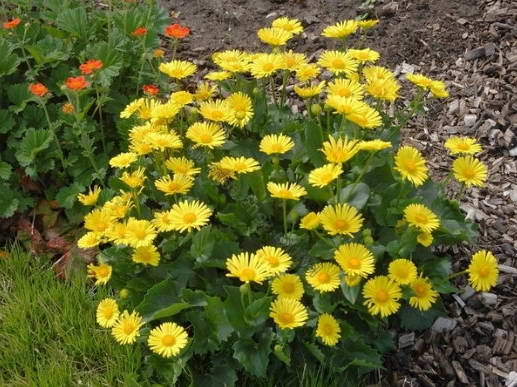

Doronicum in landscape design photo
Doronicum, one of the first to bloom on the empty spring land, looks bright, incredibly positive, becoming a real decoration. Plant marigolds, irises, primroses, and other flowers with him in order to later hide the less beautiful foliage of the faded bush.
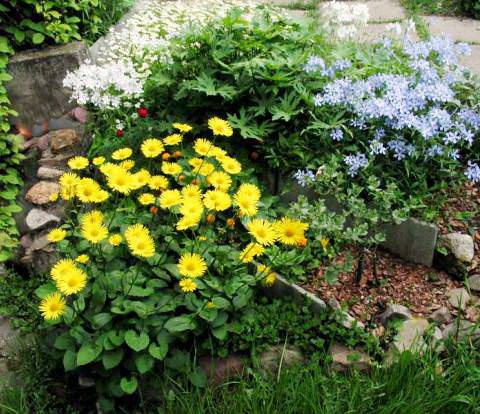

Doronicum combination with other colors
Miniature varieties are suitable for decorating a rock garden, rockery or mixborder. Doronicum adjoins remarkably with ferns, Volzhanka, Rogersia and other decorative deciduous plants.
Neat bushes are also expressive in flowerpots, delighting you on the terrace, balcony. An incredibly sunny bouquet smells sweet in a vase for about two weeks.
Use in garden compositions
Doronicum looks good in group plantings in flower beds and in mixborders, near shrubs. Good neighbors for him are forget-me-nots, daffodils and tulips, muscari, brunner.
Doronicum looks good next to forget-me-nots
Compact undersized varieties are used for decorating rockeries and planting in containers. But when choosing a place for doronicum, do not forget about its fragility - combine this plant with summer-flowering perennial or annual crops that will fill the voids when the doronicum withers.
Dwarf Doronicum varieties can be grown in containers
If you are planting Doronicum next to other perennials, leave plenty of room for it - most varieties thrive. For tall varieties, the optimal location is in the background of flower beds.
Types of doronicum with a description and photo
The genus Doronicum has about 40 plant species. However, some of the attractive varieties have become the most beloved by gardeners.
Doronicum oriental Doronicum orientale
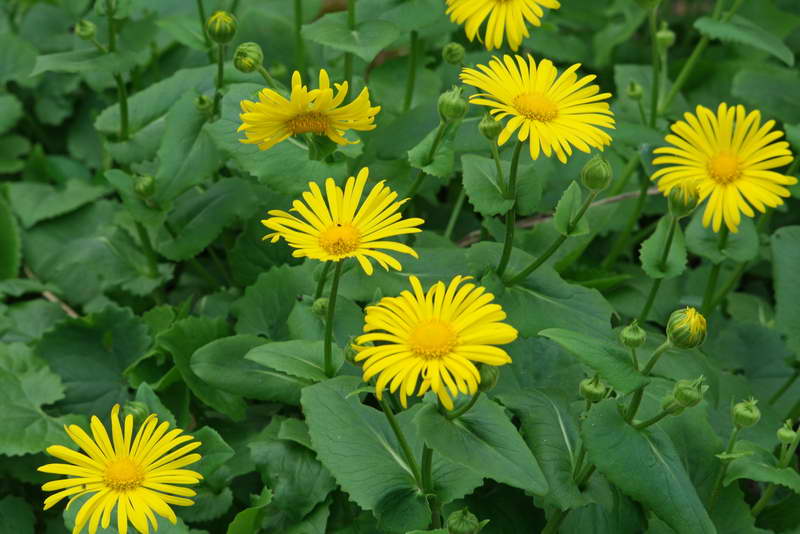

Doronicum oriental Doronicum orientale photo
A herbaceous perennial plant, reaching 30-50 cm in height, common in the Caucasus, the Mediterranean and Asia Minor. Ovate basal leaves, located on long petioles, have serrated notches along the edge. Individual flowers with a diameter of 3-5 cm are painted in a dull yellow color with a more golden middle. Blooms in mid-May.
- Little lion is a compact variety, reaching 35 cm;
- Golden gnome - an early variety with a height of 15 cm;
- Spring Beauty is a 45 cm tall plant, decorated with bright yellow double flowers.
Doronicum plantain Doronicum Plantagineum
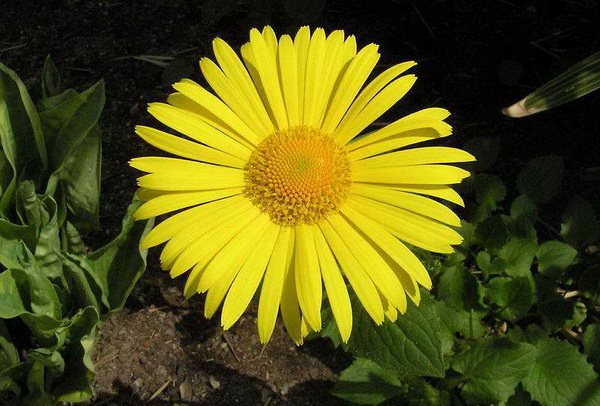

Doronicum plantain Doronicum Plantagineum photo
Features of doronicum
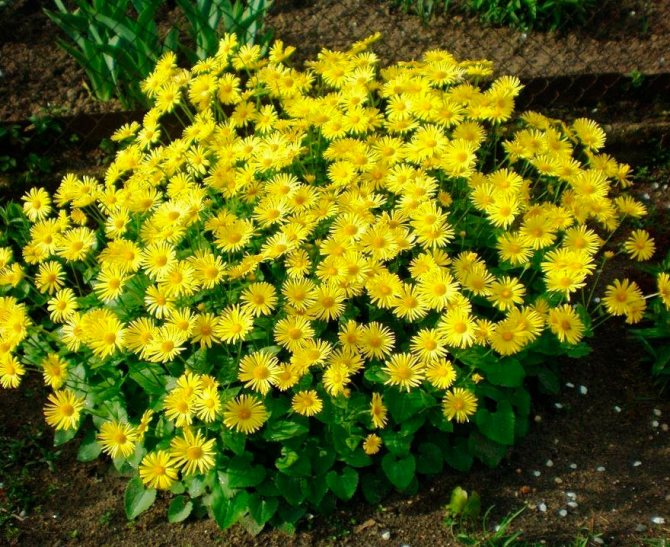

Doronicum is a herbaceous perennial plant with alternately located stem-enclosing basal leaf plates. The shape of the inflorescence baskets is hemispherical or broadly bell-shaped, 2–6 of them are collected in scutes, but there are also single ones. In the baskets, the leaves of the wrapper are placed in 2 or 3 rows. The tubular median flowers are bisexual and colored yellow; they are arranged in several rows. At the same time, the ligulate marginal flowers are female and single-row, they are also painted yellow. The fruit is a blunt, ribbed, oblong achene.
Description of Doronikum
The description of doronicum is very simple: it is a perennial plant from the Asteraceae genus, popularly called the goat. In the wild, it grows in the mountains, in temperate climates, and only one species grows in Africa. It has a shallow root system - no other is needed on poor mountain soils - narrow leaves and numerous yellow flowers.
Their middle is convex, the leaves sometimes go in one row, sometimes in several, depending on the species. Blooms in early summer or even late spring, continues abundantly and for a long time. Cut inflorescences cost more than a week.
The best part is that doronicum does not require special care - this unpretentious plant is advised to inexperienced gardeners.
Doronicum varieties and varieties
The perennial flowering plant Doronicum (popular name - goat) belongs to the numerous Astrov family. Almost 40 plant species grow in nature, which can be found in the wild in the mountain ranges of Europe and Asia.
The most common types are:
eastern doronicum (D. orientale);


Eastern Doronicum
doronicum plantain (D. plantagineum).
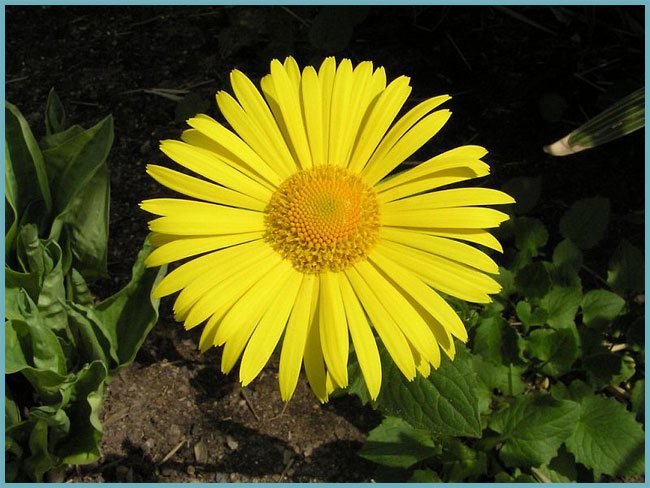

Doronicum plantain
Perennial doronicum bushes can grow without transplanting in one place for many years. The stems of the plant are simple, with little branching, very resistant to adverse weather conditions. The leaves form a basal rosette, on the stems the leaves are arranged alternately and do not have petioles.
The height of perennial doronicum differs depending on the varietal affiliation of the plant, and ranges from 0.25 m to 0.7 m.Pure yellow flowers of the goat, depending on the variety, can reach from 4 to 10 cm. The petals along the edge of the flower basket are ligulate, the core of the flower is filled with tubular petals. All Doronicum varieties bloom in May-June. When wilted inflorescences are removed, the plant produces lateral shoots on which new yellow "daisies" bloom. All varieties of goat are simply adorable (you can judge by the photos attached to the article), while undemanding to care.
Doronicum: species and varieties
There are different types of plants - about 70 in total. They all differ from each other:
Eastern Doronicum
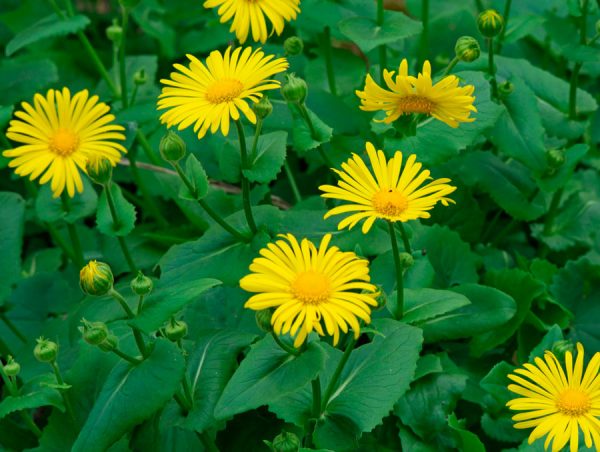

Grows in the Caucasus, the Mediterranean and Asia Minor. It reaches a height of half a meter, the edge is serrated, the eggs extend from the root, their shape is ovoid. Blooms in late May, inflorescences reach 5 cm.
Doronicum plantain


It grows up to one and a half meters, the shoots are weakly branched, they are covered with dense dark green foliage. Blooms by the end of May, blooms for a month and a half. Inflorescences with a diameter of more than 10 cm.
Doronicum Clusa
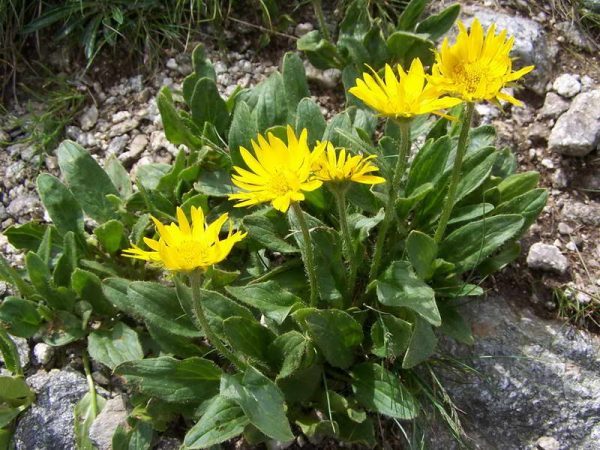

Originally from alpine meadows. Height up to 30 cm, if pinched correctly, stops at 10. Leaves with thick pile and cilia, flowers up to 5 cm in diameter. By the standards of the plant it blooms late - already in July, in the middle.
There are dwarf varieties, there are high ones. With small flowers - and with huge inflorescences the size of a human palm. But the bush always remains thick, and the flowers are yellow.
Doronicum. Handsome yellow spring flower beds
Doronicum (Doronicum) - winter-hardy perennial will delight you in early spring with very bright yellow inflorescences-baskets. Recently, not so often found in gardens, and very undeservedly. The plant is unpretentious, it grows very quickly. It blooms in the southern regions from the second half of March, and in the northern regions from mid-April. It blooms almost earlier than tulips. Long-term flowering - it will bloom in the shade for more than a month. It does not lose its decorative effect even after the end of flowering.
Family: Compositae.
Growing region: grows in the Caucasus, Europe, the Mediterranean and Asia Minor.
Usage: growing, doronicums form large, very bright bushes, completely covered with yellow inflorescences on long swaying cuttings. The field of the end of flowering, the light green leaves of doronicum do not die off, so they remain an adornment of any flower garden. The height of the flowering doronicum is from 20 cm to 70 cm. The plantain doronicum has a very high peduncle - up to 120 cm. The height of the curtain without flowers is from 10 to 20 cm. Despite the long thin peduncle, it is not prone to lodging. This only happens if it rains heavily.
Doronicum planted in the sun blooms earlier, but it will bloom a week less than the one planted in a shady corner of the garden. Therefore, it can be safely attributed to shade-tolerant plants.
Cut doronicum flowers stand for a long time in a vase.
Reproduction: propagated by seeds and dividing the bush. Both methods are not difficult.
When propagated by seeds, seedlings appear in one to two weeks. They dive after the appearance of 2-3 true leaves and in late May - early June they are planted in a permanent place. You can sow directly into the ground. Do not forget to water, otherwise all the work is down the drain. It is advisable to divide and replant the bushes every four to five years, at least. You can divide the plant from April and throughout the season. The survival rate in a new place is almost 100 percent. Planting field watering plants is required every day.
Soil requirements: not picky. Of course, it will grow better on fertilized loose soils.
Planting: It can be planted both in sunny places and in partial shade.
When planting, you need to keep in mind that, having grown, for 2-3 years, the curtain of doronicum will be up to half a meter in diameter, or even more.
It is believed that the doronicum is a sun-loving plant, but from my own experience I can say that it feels great in the shade and partial shade.
Care features: Doronicum is a very unpretentious plant. Its root system is located close to the soil surface. Therefore, probably the only difficulty in caring for it is that without watering it "lowers the leaves" very quickly, especially if it is planted in the sun. But after watering it recovers quickly. Watered at the root.
It responds well to fertilizing with mineral and organic fertilizers.
After the end of flowering, it is necessary to cut the peduncles. In addition to the fact that they will spoil the appearance of the plant, after pruning them, the doronicum will grow more quickly.
The plant is winter-hardy and does not require shelter.
Flowering: Doronicum blooms in early spring and the second time in July and early August, although not so abundantly.
Pests and diseases: can be damaged by snails, slugs, aphids. Rarely powdery mildew.
Unfortunately, doronicum is rarely planted in gardens, it is not a particularly fashionable plant and is completely in vain. It is a great decoration for spring flower beds. After a snowy winter, the golden suns of Doronicum will add a good mood even on a cloudy day. Doronicum can be found in the markets and is an inexpensive plant.
Growing from seeds


Planting doronicum usually takes place in open soil, and the effect is best obtained using seedlings previously grown from seeds. Of course, you can simply sow them in your chosen location towards the end of autumn and wait for spring to see the result.
But no one guarantees that the doronicum will rise this way. Better to be sure.
Sowing
You need to act consistently and carefully:
- prepare boxes for seedlings. This can be a juice box, an egg tray, a real pot, a wooden homemade container. It should be filled with a mixture of coarse sand and peat in a 1: 1 ratio, plus it is desirable to divide the land into separate cells;
- plant seeds. This is done in early April, no more than a couple is laid out in each cell. After that, you need to water the ground, cover the box with glass or cellophane, and put it in a well-lit warm place. Not in direct sunlight.
It will take a couple of weeks for the first shoots to appear. At this time, minimal care is needed: from time to time you need to ventilate the boxes, at the same time wiping accumulated condensate from glass or cellophane and moistening the soil.
Seedling care
When sprouts appear, they will need to be taken care of differently:
- rearrange to an even brighter place. The light should be bright, but still not direct sunlight. If the natural is not enough - and this happens in the northern regions - you will need to buy a phytolamp and put it above the boxes with seedlings;
- carry out pruning. When the sprouts reach 4 cm in height, you will need to examine the cells, identify those plants that have developed better than others, and leave them one at a time. Do not pull out the rest, but carefully cut off at ground level;
- topping. In order for the doronicum to grow beautifully, you will need to carefully pinch the tops when the plant grows 7-10 cm - so that it develops not upward, but in width;
- watering. Should be frequent, but not too profuse. Due to the peculiarities of the root system, the plant does not like excess water.
When the sprouts get stronger and there is a week left before planting, they will need to be ventilated - taken out into the street and left first for a few minutes, gradually bringing the time to half an hour. This is necessary so that they get used to external conditions and do not freeze when they find themselves in the open field.
Planting rules
Planting and caring for doronicum in the open field does not include any features. The agricultural technique is the same as for other flowers.
Planting seedlings is carried out on a sunny day, includes the preparation of a planting pit (the depth should correspond to the size of the root system) and a substrate, which consists of 2 parts of compost, 2 parts of soil and 1 part of sand.
After it is poured abundantly with water. Seedlings are planted at the end of May, since the flowering period of the doronicum falls on the summer season.
Did you know? Many varieties of the Astrov family do not retain their properties when planted with seeds. Therefore, it is better to purchase the material in the store, where the manufacturer is responsible for maintaining all characteristics when grown from seed.
Seeds
The goat in natural conditions reproduces by seeds. They are formed from the carpels of a flower and are similar to dandelion seeds. You can harvest them in the fall by cutting off the inflorescences that have faded.
Then stratify the seeds. They are placed in the refrigerator for 2-3 months. In early spring, you need to prepare a seedling box. The soil of the future planting site is well suited there.
After adding a little mineral fertilizers, you need to sow the seeds. The cover should be loose so that the seedlings have access to oxygen. After the first shoots, the plant is opened and watered with a small amount of water.
Contained at room temperature under abundant light. Picketing is carried out when the first leaves appear on young stems. Having planted the seedlings in separate containers, it is necessary to temper them by taking them out into the open air. This is done 7-10 days before planting in open ground. Every day you need to increase the time the seedlings stay on the street. Thus, they will get used to small changes in temperature and get stronger.
Dividing the bush
The division of the bush is done in autumn or spring every five years. Experienced gardeners recommend dividing the perennial at the end of its flowering. Doronicum should be carefully dug out so as not to damage the main roots.
They are then washed in a bucket of water and trimmed if tangled or too ramified.
Important! When carrying out the procedure, be sure to let the roots dry out. If the moist roots of the seedlings are transplanted immediately, the plant will die from excessive moisture.
Landing in open ground
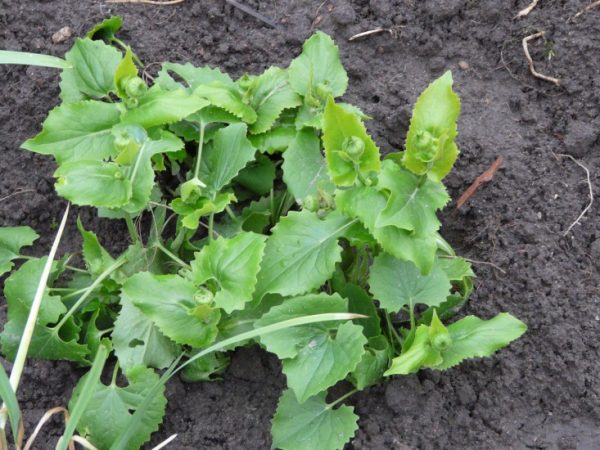

The doronicum flower is not intended for home cultivation, therefore, when the seedlings grow up, it will need to be planted on the site. Observing the necessary conditions, of course.
Timing
When warm weather sets in on the street and the spring frosts are left behind, doronicum can be planted in open ground. Consequently, the timing varies depending on the location:
- in the northern regions - at the beginning of June;
- in the middle lane - at the end of May;
- in the southern regions - at the beginning of May.
You can plant as soon as the night temperature is kept at a stable level of +10. Night frosts will simply kill tender seedlings.
Landing rules
Before planting seedlings, the earth will need to be loosened to the depth of a shovel bayonet and rotted manure added to it for nutrition. When everything is ready, you can start.
- Dig holes. Since doronicum grows in lush bushes, the distance between them should be no less than half a meter, otherwise they will greatly interfere with each other. In the dug hole, you need to fill in compost, soil and sand, pre-mixed in a ratio of 2: 2: 1.
- Plant seedlings. The plant must be removed from the cells directly from the ground - the root system has already formed in it, separation will harm it. The depth of the holes should be such that the lump of earth fits well into them. After the sprout is lowered, you need to sprinkle it with soil and lightly pat it with your palms.
- After planting, the doronicum must be abundantly moistened.
Doronicum cultivation, care, reproduction.
Doronicum is a background plant.It retains its decorative effect only during the flowering period, which begins in May and lasts about a month or a little longer, depending on the weather and growing conditions. Fading away, doronicum loses its attractiveness, its leaves die off. Therefore, next to its curtains, variegated hosts, rogers, aquilegia and other plants with a long decorative period can be planted. In such groups, it will dominate in the spring, and then other flowers will cover it, and the flower bed will remain beautiful and well-groomed. During flowering, doronicum looks spectacular in combination with daffodils, primroses, tulips, irises, common daisy. On lawns, its single and group plantings create bright spots that noticeably enliven the overall picture.
Doronicum is used in mixborders, rock gardens, rockeries and for decorating shrub groups. Sometimes it is grown specifically for cutting, trying to get a large inflorescence on a long peduncle. For this, the bush is annually rejuvenated by division, abundantly fertilized and moisturized. But it must be borne in mind that in such specimens, winter hardiness decreases and the danger of being affected by fungal diseases increases.
Doronicum is characterized by high winter hardiness and winters safely in central Russia and other regions with a similar climate. If there is a stable snow cover, there is no need for shelter, but in frosty winters with little snow it will not hurt to protect the plant by covering it with peat or spruce branches. Doronicum tolerates spring frosts normally even in the flowering phase.
Doronicum care
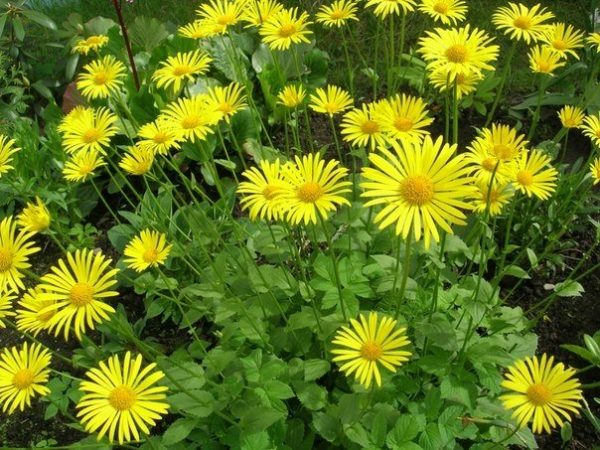

Growing doronicum does not require much effort from the gardener. It is necessary to water it from time to time, feed it and rejuvenate it once a year.
Watering
So that the water lingers a little, and the soil does not dry out, it is recommended to cover the area on which the doronicum grows with mulch - a mixture of sawdust, wood chips and cut grass.
You need to water it often, with warm water, which has been in the sun for a couple of days, but do not pour too much - the plant has a superficial root system, it does not need moisture to be absorbed deeply.
On hot sunny days, watering is required every day. In cloudy or just warm, you can water it with a break of a day or even two.
Top dressing
In the spring, when the doronicum is just awakening from winter sleep, it is fed with standard organic or complex mineral fertilizers. Then they repeat the feeding again, during the period when the bushes are preparing to bloom. The rest of the time, this aspect of care can be forgotten.
Rejuvenation, transplant
Doronicum is a perennial flower and is able to spend many years in the same place. But over time, the inflorescences begin to shrink, the middle of the bushes die off, and the overall decorative effect is lost. Therefore, from time to time you need to seat him:
- Dig up the whole bush. You need to act carefully so as not to damage the roots.
- Rinse. They are washed in warm water, then dried, because otherwise the plant will die from rot.
- Undercut. Excess roots are cut off, dried branches are removed, the bush is divided into several smaller bushes.
- Plant. According to the same rules as seedlings - the hole is deep, inside there is soil, sand and compost, clap, water.
Gardeners advise to carry out the procedure once a year at the maximum, and once every five at least.
Autumn works
In late September - early October, the overgrown clumps of doronicum are rejuvenated by division. Without this procedure, the unpretentious "chamomile" can grow for years, but over time the old shoots in the middle of the bush die off, the baskets become small and expressionless and outwardly the plantings look very sloppy. To preserve the decorativeness of doronicum, it is enough to divide adult specimens every 3-4 years. But! If you need large flowers for cutting, you will have to plant the bushes annually.
It is not necessary to intensively prepare Doronicum for winter, it can withstand even the most severe frosts without shelter.However, if weather forecasters predict a winter with little snow, for the reliability of planting, you can sprinkle with dry leaves.
Diseases and pests
And, of course, growing doronicum is often problematic.
Pests
Thrips and aphids... Insects feed on plant sap and are not dangerous in small quantities. But if a lot of them are divorced, the inflorescences will begin to die off, and the leaves will turn yellow. To cope with this, you need to buy an insecticidal agent and spray it on the bush, following the instructions.
Slugs... Small, but very harmful creatures - they gnaw through the leaves, leaving holes in them, cause exhaustion in the flower. The easiest way to deal with them is to cover the area around the bush with hot pepper. Since their abdomens are sensitive, they will not be able to get to the bush.
Diseases
Powdery mildew and rust... A white or red bloom forms on the leaves. This is often due to improper maintenance if the soil is depleted. It is necessary to treat the plant with appropriate means, and in the fall, transplant and rejuvenate.
Gray rot... It occurs with too much watering, it is treated by reducing the portions of water.
In general, Doronicum is an unpretentious and healthy plant. If all conditions are met,
Doronicum is an ideal plant for a spring garden. By the middle of spring, he spills golden lakes on the lawn, as if many small suns have descended to the ground. The plant is popularly known under the names "solar chamomile" or "goat". It belongs to the Astrov family. In the natural environment, doronicum can be found on the mountain slopes of the temperate zone of Eurasia and North Africa. Taking care of a flower outdoors is not difficult. He is quite unpretentious and tenacious. Flowers are also suitable for making bouquets and stand in a vase for a long time.
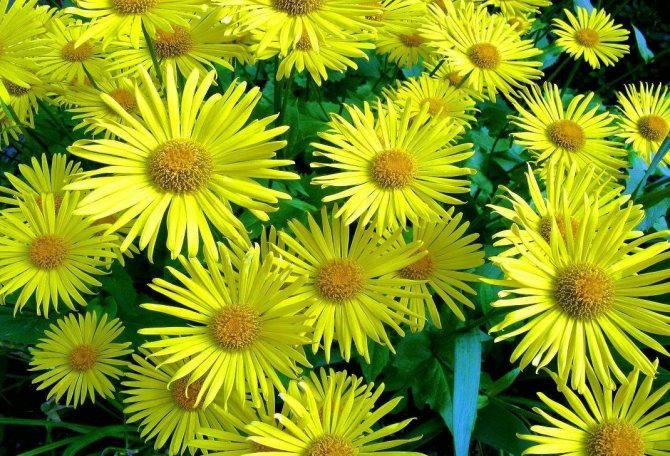

Doronicum plantain
| Latin name: Doronicum plantagineum Family: Compositae, or Astral Headings: Flowers, Medicinal plants |
Doronicum plantagineum (Latin Doronicum plantagineum) - an ornamental perennial plant; a representative of the genus of the small genus Doronicum, adjacent to the family of Compositae, or Astrov. It occurs naturally in the southern and western regions of Europe, as well as in the United States of America. Nowadays it is actively grown in many countries of the world, including Russia.
Characteristics of culture
Doronicum plantain is represented by perennial herbaceous plants, reaching a height of 1-1.4 m and bearing an elliptical or valle-elliptical petiolate basal foliage narrowed to the base. The inflorescences-baskets in the species under consideration are rather large, reach 10-12 cm in diameter, consist of tubular and lingual yellow flowers. Flowering occurs in the third decade of May, and lasts 1.5 months, sometimes longer. By the end of July, the plants lose their decorative effect, the leaves die off, and the curtains look very sad. For this reason, doronicums are recommended to be combined with other flowering and ornamental crops. The species is relatively frost-resistant, under a layer of snow it is able to withstand a short-term drop in temperature to -30C. In snowless and harsh winters, plants freeze out. Today, one large-flowered form (f. Excelsium) of doronicum plantain is presented on the garden market, its peduncles reach a height of 1.5 m, and the baskets delight with rich color and large size. For several years now, it has been a favorite among gardeners and florists, many use it to decorate semi-shaded areas and areas located near unremarkable garden buildings.
Features of cultivation
In general, plantain doronicum is unpretentious, although to obtain dense clumps with an abundance of flowers, you need to try a little in terms of providing the culture with optimal soil conditions and the most convenient location.The species in question belongs to sun-loving plants, accordingly, it should be located in well-lit areas, preferably with light shading in the afternoon. Direct sunlight can burn the delicate and juicy foliage of the doronicum, then there can be no question of any decorative effect. In general, this culture is hardy in all respects, and unlike its congeners, it tolerates prolonged drought and the scorching sun. It is not recommended to plant plantain doronicum in thick shade, in such areas it will bloom poorly. The soil for cultivation is preferably nutritious and moist, but in moderation. Damp areas are not suitable for cultivation. Soil fertility plays an important role for plants. It is noticed that in well-fertilized areas, the plantain doronicum blooms more abundantly, and the flowers are formed larger and more saturated in color.
Care
The care consists of standard procedures. Watering should be carried out as needed. By the way, all types of doronicum have a unique feature, they are able to store moisture in thick rhizomes, it follows that they tolerate drought without prejudice to growth and flowering. But in general, it is impossible to stop watering, otherwise the flowering will be scarce and inconspicuous. Watering is especially important during the formation of the baskets; it should be abundant. Another important procedure on which plant health depends is the fight against diseases and pests. They don't bother the culture very often. Among the dangerous diseases, powdery mildew should be noted, it manifests itself with thickened plantings. Aphids, snails and nematodes are also dangerous. It is quite difficult to fight the latter.
In order for the plantain doronicum to please with flowering as long as possible, the plants should be fed. One or two dressings are enough: the first is carried out after the snow melts, the second after flowering. For top dressing, it is preferable to use complex mineral fertilizers and rotted compost, fresh manure, chicken droppings and other fertilizers are not suitable.
Use in the garden
Doronicum plantain or, as it is also popularly called, yellow chamomile is actively used in ornamental gardening. The plant looks especially good in alliance with early flowering crops, such as tulips, irises and, of course, daffodils. Also, doronicums are in harmony with fern, veronica, pyrethrum, nivyanik and rogersia. It is not forbidden to plant a crop against the background of trees and shrubs with an openwork crown. Yellow daisies are beautiful in rustic gardens that do not take much time to care for. Doronicum plantain is suitable for decorating rocky gardens and flower beds, including rockeries and alpine hills, however, in the latter case, only low-growing varieties are suitable. You can grow plants along garden paths, by the porch and near the reservoir, but in a non-flooded area, otherwise the plants will start to rot and die.
Doronicum is an ideal plant for a spring garden. By the middle of spring, he spills golden lakes on the lawn, as if many small suns have descended to the ground. The plant is popularly known under the names "solar chamomile" or "goat". It belongs to the Astrov family. In the natural environment, doronicum can be found on the mountain slopes of the temperate zone of Eurasia and North Africa. Taking care of a flower outdoors is not difficult. He is quite unpretentious and tenacious. Flowers are also suitable for making bouquets and stand in a vase for a long time.
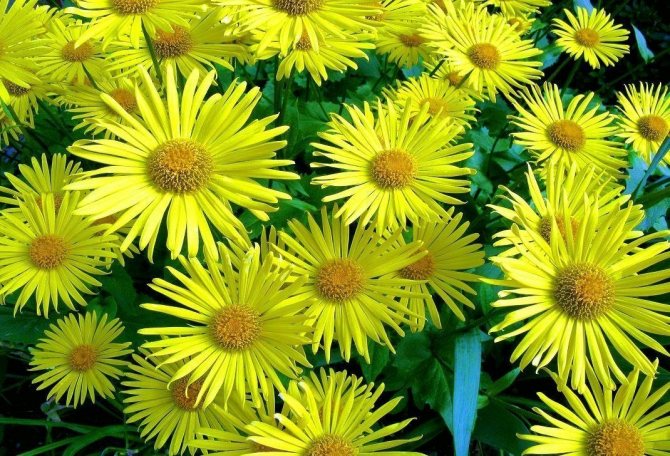

Description of the plant
Doronicum is a perennial herb. It has a fibrous superficial rhizome. Strong, erect stems weakly branching. They grow 30-100 cm in height. Along the entire length of the shoots, the enveloping stem leaves of an elongated triangular shape are located. Light green leaves are arranged alternately.At the base of the stem there is a dense rosette of leaves on long petioles. They are round or heart-shaped. Short pubescence is present on shoots and leaves. The edges of the bare stem leaves are covered with glandular formations.
Basic rules for growing
Perennial phlox: planting and care in the open field
The main points associated with planting seedlings in the ground and then caring for them are very important for obtaining beautiful, healthy plants.
Planting capacity and soil
For planting seedlings, you can use not only honeycomb containers, but also boxes, pots and cups. The main thing is to keep a distance, not thickening the landing. As a nutrient substrate, it is enough to take a mixture of peat with humus or store universal soil.
The right time to sow
Sowing for seedlings is carried out in early April, young plants are placed in open ground in early June.


Soil cutting
For planting in the garden before winter, mid-November or April is suitable.
Site selection and soil preparation
The main requirement for the soil is lightness and looseness. To prevent the seeds from falling through, you have to wait for shrinkage after digging. If the soil is depleted, rotted manure can be embedded in the beds during digging.
Important! Since the plant has a shallow root system, it is not necessary to loosen the soil under it too deeply.
Material preparation and sowing
Yellow chamomile seeds remain viable for 2 years. They sprout actively once they get into the soil, so the seedlings will have to be thinned out. Since seed material, when stored correctly, is resistant to damage and deterioration, no special preparatory procedures are required.
How to care for seedlings
With the seedling method of cultivation, seedlings appear a couple of weeks after sowing. At this time, the shelter from the container is removed and the plants are moved to a brighter place. If the weather does not please with sunny days, it is recommended to supplement the seedlings with a phytolamp.
To make the plants more lush, in the phase of the 3rd leaf, you need to pinch their tops.
Landing in the ground
A week before planting (at the end of May), it is time to take the seedlings out into the open air for hardening, first for an hour, gradually increasing the time to a day.
How to plant seedlings:
- Dig the site 20-25 cm deep. Add rotted manure;
- Dig planting holes of such a size that a root with an earthen clod would fit in them. The distance between the holes should be at least 0.4 m, because the doronicum grows strongly;
- Plant the plants in the holes, gently press the soil at the roots and pour abundantly with cold water.
Note! The goat is also grown as a houseplant, but only dwarf varieties are suitable for this.
Popular types
The genus Doronicum has about 40 plant species. Domestic gardeners have chosen only a few of the most interesting varieties.
Eastern Doronicum. Herbaceous perennial with a height of 30-50 cm is common in the Caucasus, the Mediterranean and Asia Minor. Ovate basal leaves are located on long petioles and have serrated notches along the edge. Single flowers 3-5 cm in diameter are pale yellow. The core has brighter, golden hues. Blooms in mid-May. Popular varieties:
- • Little lion - compact variety up to 35 cm high;
- • Golden gnome - early flowering variety 15 cm high;
- • Spring Beauty - 45 cm high plant decorated with bright yellow double flowers.
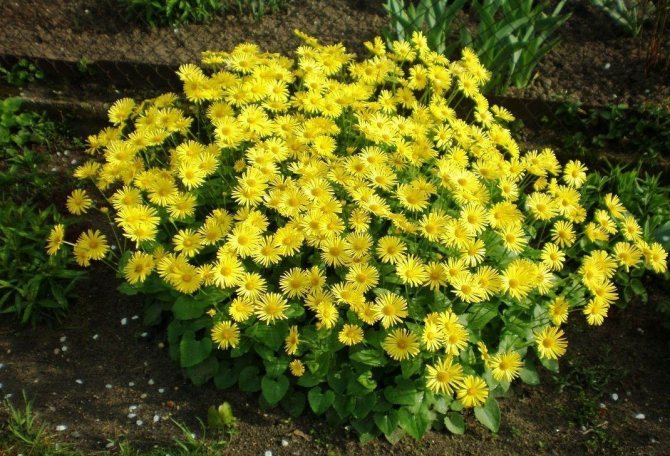

Doronicum plantain. Plant height is 80-140 cm. Its strong, weakly branched shoots are covered with oval dark green foliage. Toothed petiole leaves form a dense rosette at the base. Bright yellow baskets with a diameter of 8-12 cm bloom at the end of May and last up to 45 days.
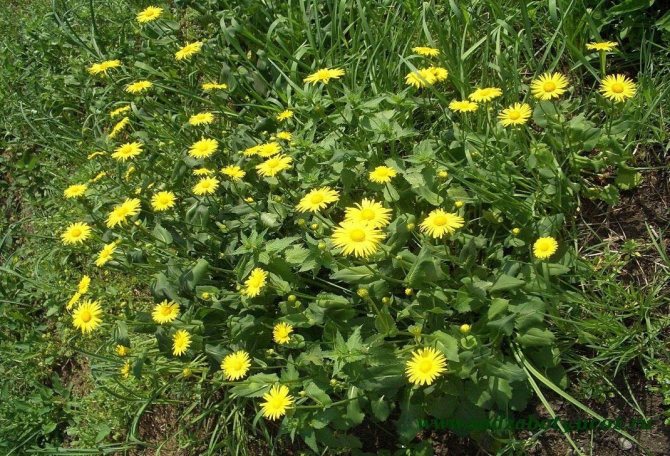

Doronicum Clusa. The plant is found in alpine meadows. Its height is only 10-30 cm.Serrated spear-shaped leaves are covered with thick hair and cilia. They are attached to the stem one by one. The shoot apex is also densely pubescent and ends with a bright yellow simple basket. Flowers with a diameter of 3.5-6 cm bloom in mid-July.
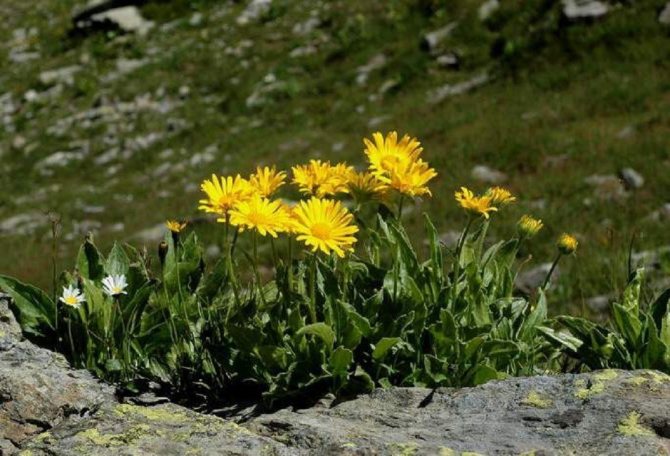

Botanical features
Doronicum (Doronicum) is a relatively small (about 40 species) genus of herbaceous rhizome plants of the Asteraceae family, or Compositae. All representatives of the genus are perennials. Wild species live more often in mountainous areas or foothills. Unpretentious and hardy, they do not require special care when growing, and to the delight of gardeners, breeders have already bred many varieties based on the most common species - Eastern doronicum (Doronicum orientale), or Caucasian (Doronicum caucasicum) and Doronicum plantagineum. Doronicum inflorescence - basket; the middle flowers are tubular, usually of brighter, more saturated shades of yellow or orange than the marginal ones are ligulate, the color of which varies from bright yellow to pale yellow. Doronicum flower Most often, the inflorescences are solitary, located on a long peduncle. The height of plants differs markedly depending on the type and variety - there are both very tiny (10-15 cm) and quite tall (up to 140-150 cm). The diameter of the inflorescences is also different: in some large-flowered varieties it reaches 10-12 cm; in most wild species, inflorescences are modest - only 4-5 cm. Doronicum basal leaves form a rosette; stems are alternate. In the axils of stem leaves, shoots with buds can form. In the axils of stem leaves, shoots with buds can form. The plant blooms earlier than other representatives of the genus, but after flowering, its aerial part withers and dies - this must be taken into account when placing doronicum in flower beds. With good care, some varieties can please with re-flowering at the end of summer. Large-flowered varieties are good for cutting.
Reproduction
Reproduction of doronicum is carried out by seed and vegetative methods. Sowing is carried out in the spring directly into the open ground or seedlings are preliminarily grown. In the garden, doronicum is sown at a temperature of + 16 ° C. This usually happens in mid-May. Seedlings begin to grow in March. Seedlings appear in 7-10 days. When 2-3 true leaves grow on the seedlings, they can be transplanted into open ground. The distance between the plants should be 30 cm. In the first year, flowering is not expected, the bush grows and increases the root mass.
Among gardeners, reproduction by dividing the bush is more common. It is held every 4 years. In August or early September, you should dig up a plant with a lump of earth and carefully divide it with your hands into several parts. Each piece is immediately planted in a new place. The plant tolerates transplanting well and quickly takes root in a new place.


Planting and breeding
Most often, doronicum is propagated vegetatively - by dividing the bush. Such an operation is good for him, because the overgrown clumps bloom worse, their central part is thinning. It is recommended to plant Doronicum every 3-4 years - the renewed plants will delight you with abundant flowering and good growth. It is advisable to divide overgrown plants It is possible to divide the doronicum in early spring (after the appearance of the first leaves) or at the end of flowering. He tolerates this procedure well. In the literature there is advice to carry out division in August-September; from my own experience, I would not recommend this: the plant is at rest, the aboveground part is absent at this time, and the empty space in the flower garden has already been closed by other cultures - why bother everyone? Dig out the bush, carefully divide it into pieces. Plant the cuttings in the planting holes at the same depth at which the mother shrub grew before dividing.Compact the soil around the plant, water well, and mulch (with humus, tree bark, grass cuttings, or other suitable materials) to conserve moisture. Doronicum reproduces easily by division. Photo by the author
For planting, choose a place in the sun or in partial shade, with loose, permeable soil. Doronicum does not tolerate stagnant moisture - its roots rot. But it will not grow on dry soil either - for the normal development of this plant, uniform soil moisture is needed. Doronicum can be propagated by seeds, which are sown in open ground in autumn or early spring; the seedling method is also used. At an optimum temperature of +16 degrees, seedlings appear in 7-10 days. The grown seedlings dive, plants are planted in a permanent place with an interval of 20-25 cm.
Transplant rules
Doronicum can grow in one place for up to 10 years. However, the plantings gradually become too dense. Powdery mildew can develop in them, and the flowers become very shallow. To avoid such a problem, it is recommended to replant and divide the bushes every 5 years.
The transplant is carried out in early spring or autumn, after the end of the flowering period. Doronicum is undemanding to the composition of the soil. However, it was noticed that on sandy soils the bushes will be slightly lower, and on black soil they will grow especially magnificently. The earth is dug to a depth of 20 cm and rotted manure is added. In heavy soils, sand and gravel must be added. After planting, the plant needs to be watered well.
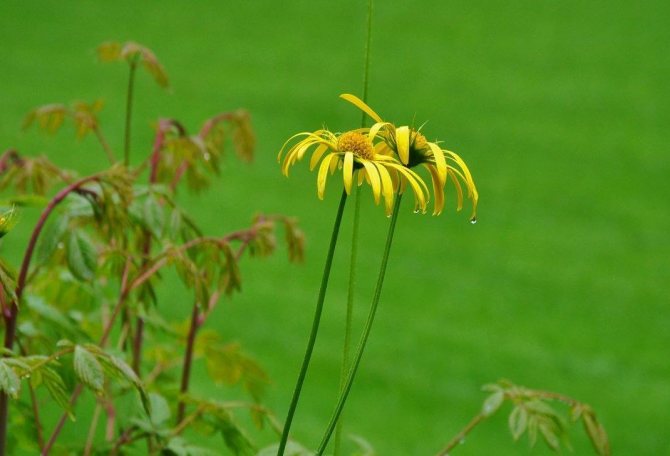

Where to plant doronicum
The goat can grow in one place for a long time. The flower needs a little space, with proper care, they do not grow. The plant easily adapts to different climates and withstands drought well.
Kozulnik goes well with other varieties of perennials. It will look interesting with the same yellow heliopsis or beard astrantia, pearl anaphalis will complement the doronicum with white, and the Italian aster will add tenderness to the flower bed due to pink inflorescences. Doronicum is planted in mix boarders and on alpine slides.
You will probably be interested to learn more about planting flowers, which also belong to the Astrov family, namely, Buzulnik, Rudbek, Nivyanik, Osteospermum, Cineraria, Cosmia, Goldenrod, Ageratum, Pyrethrum, Coreopsis, Liatrix, Gatsania.
Lighting
They bloom well in partial shade, they love coolness. The only exception is the plantain species, which blooms exclusively in the sun.
The soil
The cultivation of doronicum provides for fertile soils, loose, aerated. The flower has an interesting feature: the roots are located close to the top layer of the soil. Therefore, the soil cannot be dug up or loosened.
Sandy loam and loamy soils are suitable. The acidity is neutral. To reduce the acidity of the soil, it is enough to add young limestone during the autumn digging.
Doronicum care
Doronikums are unpretentious, it is quite simple to care for them. Flowers prefer open, well-lit areas. Some varieties can grow in partial shade. You can not plant bushes under trees, otherwise they will die due to lack of light.
The plant is resistant to summer heat and frosty winters. Even flowering specimens are capable of painlessly tolerating short-term spring frosts. In temperate climates, doronicum winters successfully under snow cover. If the winter is expected to be harsh and snowless, it is better to cover the roots with fallen leaves.
For normal growth, doronicum needs regular watering. The roots are close to the surface, so the soil will need to be moistened frequently. Regular watering will help extend the flowering period. To prevent the soil from drying out too quickly, its surface can be covered with mowed grass or wood chips. At the same time, excessive dampness and stagnation of water in the ground should not be allowed.
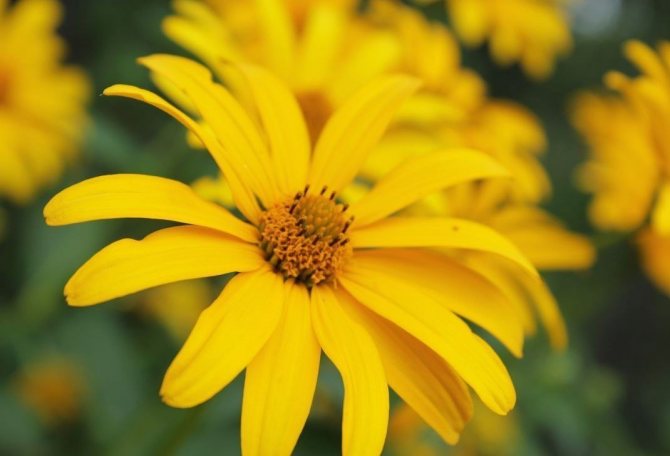

At the beginning of flowering, it is recommended to add a solution of mineral fertilizer once.On fertile soils, the need for feeding is not so great, but the plant will respond to it with gratitude.
To avoid unregulated self-seeding, it is recommended to cut off wilted buds immediately. At the end of flowering, the leaves begin to dry out and lose their decorative effect. The shoots can be partially cut. Resting watering is also less important. It is carried out only during periods of prolonged drought.
Doronicum occasionally suffers from powdery mildew. Its leaves are popular with slugs, aphids and snails. Traps and chemicals are used against parasites.
Growing and care
Doronicum is undemanding to the soil, practically does not need additional fertilizing, but it will be grateful if, when planting, you add compost to the planting hole. Abundant nutrition will make the plant more powerful, and the flowering - plentiful, but such "overfed" bushes winter worse - keep this in mind. It is better to stimulate flowering by regular plant rejuvenation. Doronicum is an undemanding plant. Photo by the author If the weather is dry during the flowering period, the doronicum needs watering. Use mulching to retain moisture in the soil. In the resting phase, the plant calmly tolerates drought. It is not recommended to loosen the soil around the bush - the root system of the doronicum is superficial, it is easy to damage it. When finished flowering, trim the plant back. Fading foliage, if it spoils the appearance of the flower garden, is removed; if the landing site is chosen successfully - the partners of the doronicum hide its lost appearance, additional intervention is usually not required. Doronicum is frost-hardy, does not need shelter for the winter. It is resistant to diseases, but in unfavorable conditions it can be affected by powdery mildew. Diseased plants are destroyed to prevent infection of the rest.
Use in landscape design
Doronicum is indispensable for decorating a flower garden. It is one of the first to bloom in the spring. On bare ground, golden islands look especially beautiful. To decorate less attractive foliage after flowering, doronicum is planted along with marigolds or other flowering plants (irises, primroses, aquilegia). Miniature varieties are suitable for decorating a rock garden, rockery or mixborder. Doronicum looks great in the vicinity of ferns, Volzhanka, Rogersia and other decorative deciduous plants.
Compact bushes are effective not only in the open field, but also in flowerpots. They will decorate a terrace or balcony. A bouquet of bright sunny daisies will exude a pleasant aroma and will stay in a vase for up to two weeks.
Conditions
Caring for the doronicum includes not only watering and cultivating the soil, but also the selection of suitable conditions. Care must be taken that the plant is neither too cold nor too hot, and that the soil is sufficiently nutritious for it.
Place on the site
Doronicum loves sunlight, but not so much that it can withstand direct exposure to rays, therefore it must be placed in partial shade. It is better to choose a place far from trees, otherwise the flower will lack nutrients. Interestingly, plantain doronicum is the only plant species that not only tolerates bright sun, but also grows best under its rays.
The soil
The soil should be loose and fertile, with neutral acidity (to get it, it is enough to scatter limestone or dolomite flour on the site towards the end of autumn). Sandy loam and loamy soils are suitable.
Doronicum: Medicinal properties and contraindications
Doronicum Hungarian has medicinal properties. The culture is rich in flavonoids, quercetin, rutin, essential oils, sesquiterpenoids, and phenol. For the preparation of medicinal infusions, basket-like inflorescences are used.
Folk remedies based on doronicum (infusions) have an anti-inflammatory effect and are used for rheumatism, stomatitis and neuralgia.When preparing the infusion, the proportions should be strictly observed, since the plant is very poisonous and if they are not followed, you can get serious poisoning.
Pregnant and lactating women, as well as those people who have an individual intolerance to the components of the plant, should be abandoned from the treatment of doronicum.
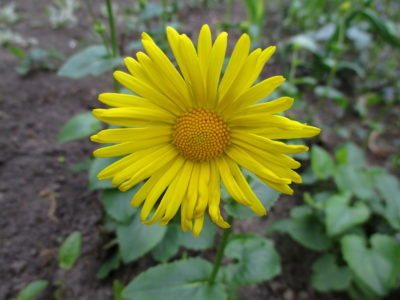

Preparing doronicum for winter
Although the plant is resistant to frost, so that it successfully overwinters and does not freeze, when the first frosts begin, it must be cut off, and the roots must be covered with a thick layer of dry foliage. Such a shelter will protect them from freezing.
If the winters in the region where the culture grows are warm and snowy, the doronicum can not be covered, since it winters well under the snow.
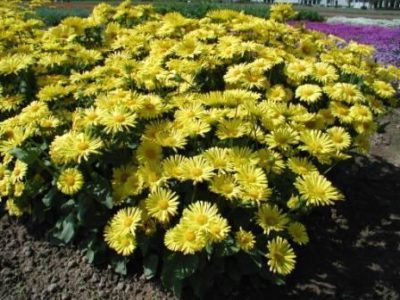

General description with photo
Doronicum is the representative of the Astrovs. It is ubiquitous in Eurasia; you can often see its flowering meadows in North Africa. It prefers to settle on mountain slopes, from which it becomes clear that this is a rather tenacious and unpretentious plant. It is a herbaceous perennial with a fibrous rhizome, which has a superficial bedding. Shoots are straight, leafy along the entire length, strong, with weak branching, capable of stretching up to a meter in height, but you can often find compact garden forms that do not exceed 15 cm. Bulky stem leaves have a triangular shape and regular arrangement, a light shade of green. At the base, long-petiolized leaves of a different, more rounded heart-shaped form grow, forming a lush basal rosette. Both those and other leaf plates have short, slight pubescence.
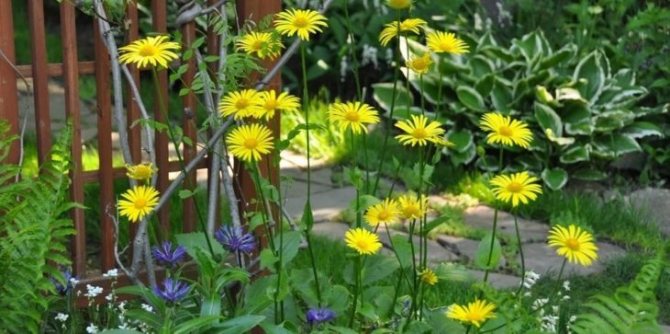

Flowering occurs early, in the second half of spring. Chamomile but slightly narrower petals are bright yellow. Flowers up to 12 mm in diameter bloom at the tops of the shoots, can be either single or formed into loose corymbose inflorescences. In the photo of doronicum flowers, the central lush core, which usually has the same color, is clearly visible.
In place of the pollinated inflorescences, a miniature seed capsule is formed no more than 2-3 cm in length, inside which very small crested seeds ripen.
Doronicum seeds are able to remain viable for no more than 2 years.
Preparing for landing
Planting material
When buying seeds, you need to pay attention to the date of collection and the deadline for sale. Doronicum seeds retain high germination only during the first 2 years after collection. When planting seedlings, it is worth considering that about 30-35 copies are planted for each square meter of a flower garden.
Planting site and soil
The light-loving plant prefers open sunny areas, but in shady or partial shade conditions, larger inflorescences are formed and the flowering period is significantly increased.
The soil on the site should be light, nutritious, loose and preferably slightly acidic. 2-3 weeks before planting, it is recommended to dig up the area (about 20-30 cm in depth) and add rotted organic matter into it.
Neighborhood and combination with other cultures
Doronicum is a wonderful neighbor for most plants. It can be grown in flower gardens and flower beds, on balconies and terraces, as a single plant and in a large flower company. Excellent neighbors will be: Volzhanka, fern, Rogersia, marigolds, primrose, irises, aquilegia, tulip, daffodil, daisy and many others.
What is Doronicum?
The goat is easily adaptable to almost any weather conditions and easily tolerates a dry period. Therefore, the doronicum will be comfortable, both in a partial shade and in a sunny place.
The only exception is the plantain variety; only a sunny meadow is suitable for it. Experienced gardeners note that doronicum blooms much longer in a semi-shady place than in the sun. The flower is easily combined with other perennial plants.Looks especially good together with yellow heliopsis, pearl anaphalis, Italian aster. These flowers will add a special charm and tenderness to the flower bed.
Kozulnik (doronicum): choosing a place for planting, care features
Bright yellow goat daisies are like the sun - they successfully complement flower gardens in the spring, filling every corner of your garden with bright and fresh colors. These flowers are sometimes grown for cutting and last long in bouquets.
The stems, foliage and flowers of almost all types of doronicum are poisonous, this feature of the plant is indicated by its name, it comes from the Arabic word doronish, which means an unknown poisonous plant.


Botanical description
Doronicums are herbaceous plants for open ground, vegetating for many years in a row. They have typical aster inflorescences-baskets typical for the family, which can have a hemispherical or bell-shaped shape. Usually, the inflorescences are placed on the branches one by one, but in some species they are collected in groups of up to 8 pieces.
The diameter of the corolla reaches 12 cm. The wrapper of the inflorescence is green, the leaves are arranged in 2-3 rows.
The doronicum flowers themselves are yellow, similar to chamomile, and can be of two types. The first are tubular bisexual, arranged in multiple rows in the center of the inflorescence. Along the edge there is a row of reed flowers of a female structure.
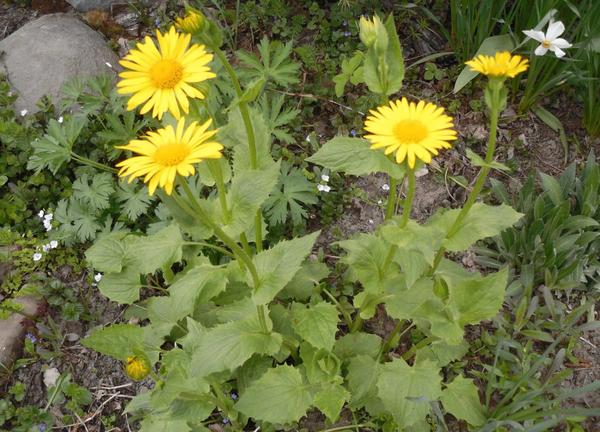

Doronicum fruits are called achenes. They have an elongated shape and longitudinal ribs. Fruits are dark when ripe, cream or light green when unripe. Small seeds - in one gram up to 6000 pieces. Germination lasts up to 2 years.
The rhizome lies in the surface layer of the soil, has a fibrous structure. Stems are straight, short, almost not branching. In some species of goat, their length reaches 1 m.
The leaves are triangular, alternately arranged. There is a rosette of plates on elongated petioles near the soil. They differ from the rest of the leaves in more rounded edges.
The vegetative parts are slightly pubescent. On the edges of the plates there are glands that emit water droplets and essential oil, thanks to which the plant smells pleasant. In folk medicine, doronicums are used to prepare cough medicine.
Watering doronicum
The culture has a shallow root system, therefore it requires regular and frequent watering. However, it should be borne in mind that there should be no overflow, otherwise the doronicum may die. You need to water it with settled and warm water.
After watering, loosen the soil and carefully remove the weeds by hand. If, when planting seedlings, a bed with plants is mulched, then a layer of mulch will prevent the appearance of weeds and the rapid evaporation of moisture.
Elecampane is also a member of the Asteraceae family and has medicinal properties. Grown when planting and nursing in the open field without much hassle, if you follow the rules of agricultural technology. All the necessary recommendations can be found in this article.
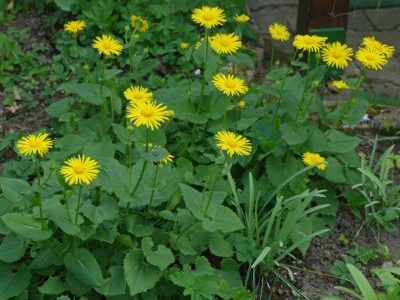

What time to plant
Doronicum seedlings are planted in open soil only when warm weather sets in, while spring return frosts should be left behind. As a rule, this time falls on the last days of May or the first days of June. When about 5 days remain before the seedlings are planted in the garden, you need to start hardening them. To do this, the plant is transferred to the street every day, while the duration of such a procedure should be increased gradually. At the beginning of the seedlings, it is necessary to provide reliable protection from wind, precipitation, direct sunlight and drafts.
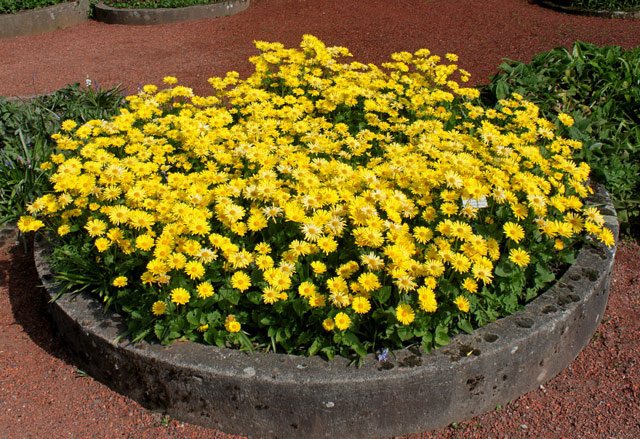

Fertilizing and feeding doronicum
Fertilizers for doronicum should be applied during spring loosening of the soil. At this time, it is useful to feed the plant with a full complex fertilizer.
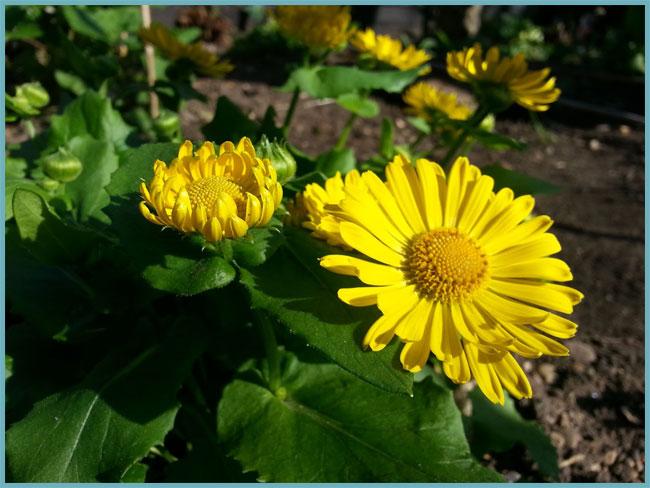

For doronicum, both organic and mineral fertilizers are useful.
At the moment of regrowth of new outlets, it is useful to feed the plant with organic fertilizers with a high proportion of nitrogen content.This will help the plants grow greener faster.
Doronicum: combination with other plants
Bright yellow "daisies" of Doronicum go well with garden perennials: Veronica, Cochinacea, ostrich, ferns, Rogersia. The combination of yellow flowers of doronicum with perennial nivyanik and pyrethrum is very decorative.
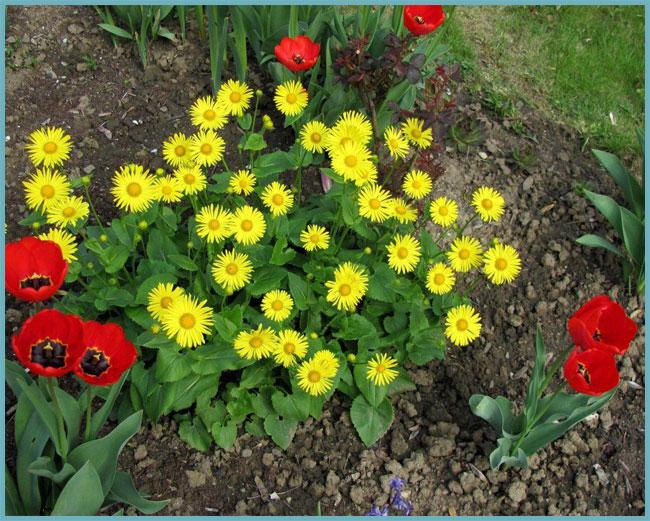

Doronicum in combination with tulips
As a background plant, the goat looks gracefully against the background of monolithic greenery, near shrubs and stunted trees. Fits perfectly into landscape design compositions in a rustic style.
Content
- Doronicum species and varieties
- Doronicum planting and care in the open field
- Watering doronicum
- Soil for doronicum
- Fertilizer for doronicum
- Doronicum flowering
- Pruning doronicum
- Doronicum transplant
- Preparing doronicum for winter
- Reproduction of doronicum
- Diseases and pests
- Doronicum: Medicinal properties and contraindications
- Conclusion


Possible growing problems
Although yellow chamomile is a non-capricious plant, there are still problems with its cultivation. They can be solved using special products and adjusting the care regimen.
Pests
The ubiquitous aphids and thrips do not ignore the yellow daisy. Small insects sucking sap do not cause significant harm at first. But, having multiplied, they are able to lead the doronicum to death.
There are many different insecticides that can be used to successfully control parasites. It is enough to process the planting according to the instructions, and small parasites will not be afraid of the garden “suns”.
Sometimes slugs eat up the foliage. To prevent their appearance, it is enough to sprinkle the soil around the flower with hot, ground pepper. The sensitive abdomen will not allow harmful creatures to overcome the obstacle.
Diseases
Gray rot appears on plants in thickened plantings, with excessive watering. It is advisable to thin out the plants, remove the infected parts and adjust the watering regime.
Rust and powdery mildew also most often attack waterlogged plantings. In this case, watering must be reduced, the damaged parts of the plant must be removed. Spray doronicum with Topaz or another preparation of similar action.
Signs of improper care
Doronicum can give small flowers if it has not been planted for a long time. For rejuvenation, the plant is dug up and divided into parts. New flowers on the renewed goat will be noticeably larger. Another growing problem is the excess of light. When placing a plant on a site, it is worth remembering that, although the doronicum is photophilous, excessive exposure to the rays of the sun provokes the crushing of flowers.
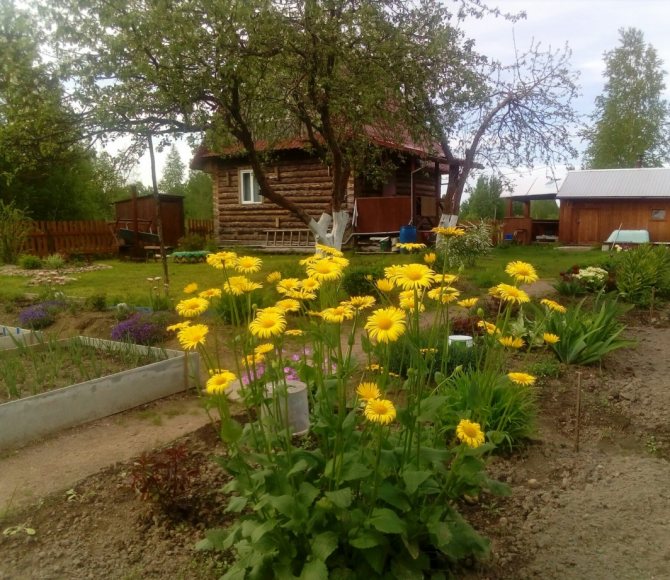

Kozulnik on the site
Planting and caring for doronicum outdoors is extremely simple. Even a beginner can cope with them, who will be doubly pleased to enjoy the bright flowering of a garden pet.
Reproduction of perennial doronicum
Doronicum propagation is carried out by seeds and dividing the bushes. Possible podzimny or spring sowing.
It is quite easy to propagate by seeds this crop. Seeds can be planted directly in open ground, or seedlings can be pre-grown. Before sowing the seeds, the ridges are prepared. To do this, they are dug up, fertilized, the surface is leveled and shallow furrows are made. Seeds are planted at a distance of 6 - 7 cm from each other. Then the soil is leveled, the seeds are covered with a layer of earth and watered. After planting doronicum seeds in open ground, you will need to take care of the crops, which will consist in regular watering and removing weeds.
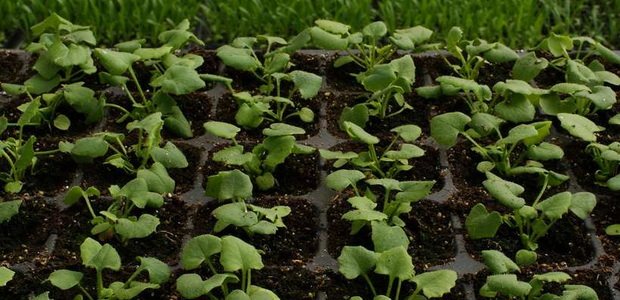

When growing seedlings, the seeds are placed in small pots and covered with foil, thereby creating a mini-greenhouse. After the shoots appear, the shelter is removed. I dive plants when they form the first pair of leaves.
In autumn or spring, 4-5-year-old bushes are divided, choosing strong, well-grown plants.The bushes are dug up together with an earthen clod, the delenki are planted at a distance of 30-40 cm from each other. After planting doronicum flowers, care for young plants should not be neglected, so they will quickly get stronger and get used to a new place.
Conditions for growing doronicum
In order for a perennial to please with its lush green foliage and bright long flowering, the gardener needs to get acquainted with the growing conditions of this plant and try to comply with them.
Location. When choosing a place for planting doronicum, it must be borne in mind that it grows well in open sunny areas, is not afraid of light partial shade, this must be taken into account when choosing a place for planting this culture. The plantain species is more susceptible to sunlight than other species.
You should not plant bushes near large spreading trees, which will create a shadow over the doronicums and inhibit their growth and development.
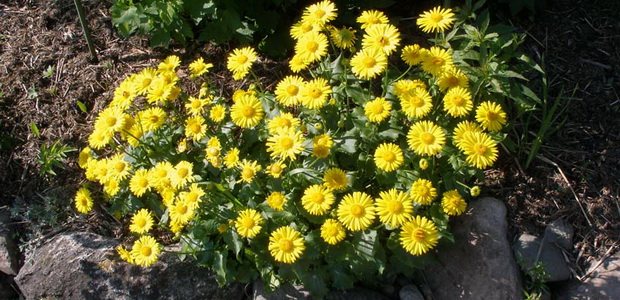

The soil. Prefers any garden, well-drained, loose, nutritious soil. Doronicum grow well on any soil, but on black soil, the bushes quickly grow in width. On sandy soils, the bushes are more squat.
Watering. Watering is also part of the care of the doronicum, but often this work is not required, it is necessary to moisten the soil only in dry weather. Its root system accumulates a sufficient amount of moisture during rains, this allows doronicums to bloom even in a hot dry period, without losing their decorative effect. In wet weather, protection of the bush from snails is necessary. After watering, you can loosen the soil around the bush and remove weeds, but this must be done very carefully so as not to damage the surface root system of this culture. The plant will greatly benefit from mulching the area near it with fresh cut grass, wood chips or sawdust.
Top dressing. Before flowering, top dressing with full mineral fertilizer.
Transfer. This culture does not need frequent transplants and can grow in one place for more than 10 years. However, the bushes grow strongly, lose their decorative effect, and the buds become smaller. For this reason, it is recommended to replant the plant every 5 to 6 years. The division is carried out in the fall after flowering and before the onset of frost.
Before transplanting the plant, you need to dig up the ground to a depth of about 20 cm, add rotted manure, and after planting, water the bushes abundantly.
Frost resistance. The plant is winter-hardy, does not require shelter for the winter. Before wintering, you need to cut off the shoots, leaving no more than 3 cm from the soil surface. With the onset of warm spring days, the bushes will grow back.
Pests and diseases. As the practice of experienced gardeners shows, if the planting of doronicum and the care of this plant were carried out correctly and regularly, pests and diseases will not disturb it.
In some cases, the bushes can be affected by a disease such as powdery mildew. When it is detected, it is advisable to use biofungicides.
Among pests, the greatest danger to doronicum is aphids and nematodes. Fungicides are effective against aphids, with which you need to treat the bush according to the instructions. It is useless to fight nematodes, so the affected plant will have to be dug up and burned.
Doronicum flowering
Doronicum blooms from mid-June to late July. Some of its varieties bloom in late May and finish blooming by mid-June. The inflorescences of the culture are single, basket-shaped, with a yellow-orange tint.
They can look like chamomile, dandelion, or aster. Everything will depend on the variety. After flowering, seeds begin to ripen, which are used by gardeners to propagate doronicum.
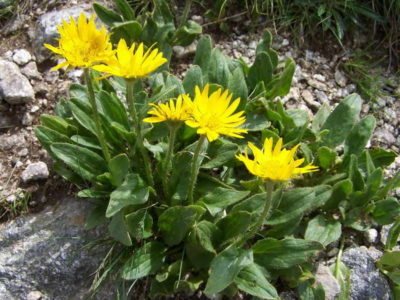

Sowing
Doronicum is grown from seed through seedlings and this is the most reliable method. However, seeds can be sown directly into open soil, they do it before winter in late autumn or in May.Sowing for seedlings is carried out in April; for this, a cellular tray is used, into which an earth mixture is poured, consisting of coarse sand and peat (1: 1). 2 or 3 seeds are sown in one cell, then the container is covered with a film (glass) and transferred to a place protected from direct rays of the sun (light is needed bright, but diffused). It is very easy to care for crops. To do this, they need to be systematically ventilated, the accumulated condensate must be removed from the surface of the shelter, and, if necessary, the soil mixture must be moistened with a spray bottle.
Landing rules
Such a culture is photophilous, but it can also grow in a shaded place. In order for the inflorescences of the basket to be very large, a semi-shaded area should be chosen for planting doronicum. But keep in mind that near a tree not far from the trunk, such a flower will develop and grow very poorly. The soil on the site must be loose and moist (not wet).
Prepare the site for planting, for this, dig it to a depth of 20 to 25 centimeters, while manure must be added to the soil. When planting seedlings, remember that after 2 or 3 years the clumps of bushes will grow strongly, while in diameter they will reach about 0.5 m and even more. In this regard, a distance of 0.4–0.5 m must be maintained between the planting holes. The hole must have such a diameter and depth that a plant, taken together with a lump of earth, can fit in it. When the seedlings are planted, the soil surface around the bushes is tamped a little, and then they are well watered.
When and how it blooms
Doronicum is a flower that can change the size of the petals and the intensity of color depending on weather conditions. In general, the flowers are similar to small daisies, which is why they are often confused with feverfew. The color of the petals is bright yellow, the center may be darker, up to brown. In diameter, inflorescences are from 4 to 15 cm, depending on the variety.


Doronicum flowering
Flowering begins in spring and lasts all summer. Cut doronicum flowers can stand in water for up to 14 days, keeping their fresh appearance.

